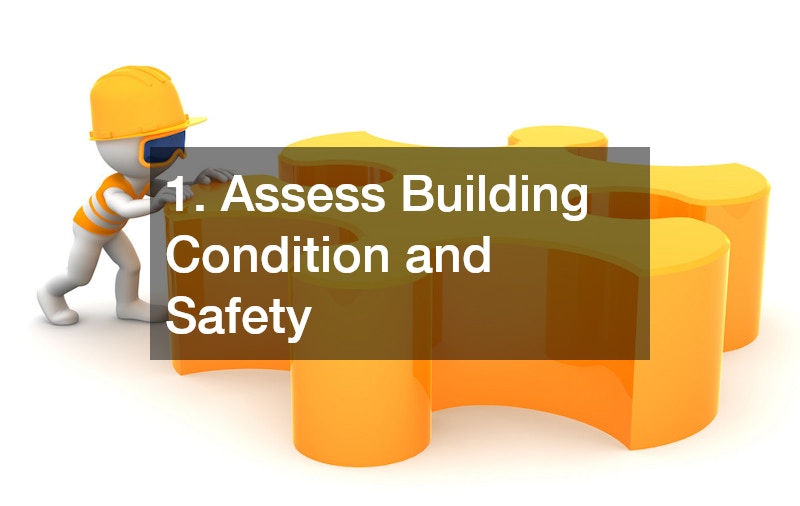Undertaking the task of renovating a commercial building can be a significant endeavor, but the rewards often far outweigh the challenges. Proper renovations have the potential to not only improve the safety of the structure but also enhance its overall aesthetic appeal, making it more inviting for customers and employees alike. Additionally, renovations can significantly increase the property’s market value, creating a more competitive and attractive space for future tenants or buyers. This comprehensive guide is designed to walk you through the essential considerations and preventive measures that will help ensure your renovation project is successful and efficient, saving both time and money in the long run.
Renovations provide the perfect opportunity to integrate modern amenities that can greatly influence operational efficiency and improve the customer experience. Incorporating features like energy-efficient materials, cutting-edge technology, and smart building systems can help optimize the building’s performance while reducing operational costs. These upgrades are particularly important in today’s eco-conscious market, where sustainability can be a key factor in attracting clients and tenants. Additionally, the thoughtful inclusion of modern infrastructure, such as high-speed internet access or enhanced HVAC systems, can provide a distinct competitive advantage, positioning your business as a leader in innovation. Understanding the broader impact of these renovations—how they can optimize your business operations and contribute to long-term success—is essential for any company looking to invest in their physical space.
When planning a renovation, balancing aesthetic upgrades with functional improvements is critical. While the look and feel of the space should be a top priority, it’s equally important to ensure that practical considerations are not overlooked. A well-thought-out renovation plan should address not only the visual appeal of the building but also factors like safety, accessibility, and the building’s environmental impact. Careful consideration of these aspects ensures the space meets legal and regulatory requirements, while also providing an environment conducive to the growth and well-being of employees and customers. By adopting best practices, collaborating with reputable contractors, and maintaining clear communication throughout the renovation process, you can mitigate risks and help ensure a smooth, successful renovation journey that results in lasting benefits for your business.
1. Assess Building Condition and Safety

The first and most important step in renovating a commercial building is to thoroughly assess the current condition and safety of the structure. This involves inspecting the building for any existing damages, such as water leaks or structural deficiencies. A comprehensive assessment is crucial to identifying areas that require immediate attention.
Hiring professionals such as a local chain link fence company can help reinforce security measures around the property. Safety protocols should extend to internal systems, ensuring that utilities like water treatment systems and electrical wiring are up to date. Working with skilled technicians like those from pump and well services can provide insights into necessary plumbing repairs and maintenance needs.
An in-depth evaluation will help prioritize what needs immediate action and what can be improved consecutively. This step reduces unforeseen expenses and guarantees that renovations do not compromise the building’s safety. Collaborating with a team of experts ensures that all potential vulnerabilities are identified and addressed efficiently.
2. Evaluate Compliance with Local Codes
Renovating a commercial building involves adhering to local building codes and regulations. These guidelines are established to ensure the safety and well-being of the building’s occupants. Ignoring these codes can result in costly penalties, fines, or even halt construction efforts altogether.
It’s crucial to consult with city planners or regulatory bodies to understand specific requirements applicable to your project. This may include assessments of the building’s structure, electrical, plumbing, and HVAC systems. Compliance with local codes might also necessitate integration or upgrades of water treatment systems, plumbing repairs, and other essential services.
Engaging with contractors experienced in local regulations can prevent oversight and ensure that every aspect of your project is up to par. Whether it’s collaborating with a metal roofing contractor for structural compliance or verifying parking lot striping with local zoning laws, due diligence in this phase safeguards the integrity of the whole renovation process.
3. Prioritize High-Traffic Areas
Focusing on high-traffic areas is a strategic move when renovating a commercial building. These spaces often endure the most wear and tear and require durability. Prioritization of such areas ensures they can sustain heavy usage over time.
Improvements might involve applying durable flooring solutions or employing concrete ready mix to strengthen foundational elements. Enhancing lighting or accessible signage can also contribute to better traffic flow and safety. Employing specialists such as landscape lighting companies can amplify visual appeal while ensuring functionality.
Addressing aesthetics and functionality in high-traffic areas boosts overall satisfaction for visitors and employees. Proper design and material choice within these spaces directly influence the perception of the building’s quality. Ensuring these are prioritized in the renovation can lead to increased business activity and customer satisfaction.
4. Conduct an Energy Efficiency Audit
In today’s environmentally conscious climate, conducting an energy efficiency audit is highly advisable when renovating a commercial building. This audit evaluates how energy is used in the building and identifies opportunities for enhancement. Implementing energy-efficient solutions can significantly cut costs in utility bills over time.
Upgrading heating and cooling systems, incorporating efficient lighting, and sealing windows can dramatically improve energy usage. Water treatment systems also play a vital role, as efficient systems can reduce water wastage. Engaging with a knowledgeable professional in pump and well service can further ensure efficient water management throughout the building.
This audit not only aligns with sustainability goals but also supports compliance with energy-related building codes. Leveraging these insights can provide substantial cost savings while promoting environmental stewardship. Making informed energy-efficient decisions fosters a more sustainable commercial environment.
5. Focus on Long-Term Durability
Ensuring longevity and durability in building renovations is vital for sustained success. This involves choosing materials and service providers that align with long-term resilience goals. Attention to detail in selecting these can greatly prolong the building’s longevity with lower maintenance requirements.
Partnering with a reputable metal roofing contractor, for example, helps establish a top-quality roof installation and roof repairs over time that withstand extreme weather conditions. Similar focus should be applied to elements like concrete ready mix, ensuring a solid foundation for any construction. Establishing relationships with trusted local partners, such as a local tree cutting company, further ensures ongoing maintenance is handled correctly.
The goal is to create a robust infrastructure that does not succumb to premature degradation. This consideration cuts down on future repair costs and provides a stable commercial space for business operations. Integrating high-quality materials and expert craftsmanship is pivotal in achieving durability.
6. Maximize Space Utilization
Effective space utilization is essential for realizing the full potential of any commercial building. Thoughtful design changes can better use the space available, whether for office operations, retail environments, or industrial uses. Maximizing space ensures heightened productivity and functionality.
Assessing underutilized areas and converting them into valuable workspaces can be transformative. This task may involve reconfiguring office layouts or adding new features that have direct applications, such as strategic use of partition walls or efficient storage solutions. Concepts like open-floor plans often attract more customers while boosting employee synergy.
Technology can further aid in space utilization by employing innovative solutions that streamline operations. Assessments of technological infrastructure needs are vital in this context. Implementing tech-driven solutions can enhance productivity and workflow efficiency, aligning with the overall goal of optimal space utilization.
7. Prioritize Accessibility Features
Renovating a commercial building with accessibility in mind cannot be overstated. Compliance with laws such as the Americans with Disabilities Act (ADA) is non-negotiable. However, accessibility goes beyond regulations and speaks to inclusivity, promoting a welcoming environment for all individuals.
Implementing accessible routes such as ramps and wider doorways can make substantial differences. This may also mean adopting advanced features such as speaking directory systems or visually impaired assistance devices. Partnering with experienced professionals ensures these features are incorporated seamlessly into the existing infrastructure.
Prioritizing accessibility can set a business apart, fostering goodwill among customers and employees alike. These considerations align a company with societal standards while improving customer experience. Proper planning and execution in accessibility-focused renovations expand the reach and scope of the business operations.
8. Consider Customer Experience

Renovations offer a prime opportunity to enhance customer experience in a commercial building. Thoughtful design improvements need to focus on aspects that enrich attractiveness and functionality. Creating an inviting atmosphere positions the business favorably in the market.
Details such as ambient landscape lighting installed by landscape lighting companies can significantly affect first impressions. Incorporating comfortable seating, modern waiting areas, and clear signage improves navigation and perceptions of service. All these changes combined foster a positive interaction experience for both customers and staff.
Paying attention to customer feedback during planning can yield invaluable insights into necessary upgrades. Integrating desired changes into the renovation makes the building more aligned with customer expectations. A well-considered approach to renovation highlights a commitment to service, a sentiment customers remember and appreciate.
9. Assess Technological Infrastructure Needs

Technology plays a pivotal role in the effective operation of modern commercial spaces. Identifying and integrating the right technological infrastructure is a key concern during a renovation. Meeting current demands while anticipating future technological advancements safeguards adaptability.
Adopting the latest trends, whether updating Wi-Fi capabilities or integrating smart building solutions, can vastly improve operations. Collaboration with industry specialists ensures the installation of robust technology that supports your goals. Renovations present the perfect opportunity to enhance these technological frameworks, ensuring longevity and adaptability.
Being forward-thinking in this area can prevent costly retrofitting and ensure compatibility with emerging innovations. By evaluating technological needs early, decision-makers can keep pace with developments. Investing in the right infrastructure helps solidify the building’s utility and allure in competitive markets.
10. Evaluate the Impact of Renovations on Business Operations

Embarking on renovating a commercial building necessitates consideration of the impact on regular business operations. Missteps in project planning can lead to substantial financial implications or operational disruptions. Foreseeing and preparing for these challenges is critical to minimizing adverse effects.
Involving organizational leaders during the planning stages can help ensure alignment with business objectives. Balanced scheduling and strategic planning mitigate disruption risks and uphold day-to-day functionality. Proactive communication channels with employees and stakeholders are vital for maintaining clarity and managing expectations.
Exploring temporary workarounds such as flexible scheduling or remote work can provide alternatives during the renovation phase. Strategic planning, coupled with adept management skills, helps the business adapt while improvements are underway. A successful renovation requires harmonious coordination, with minimal impact on regular operations.
Undertaking the renovation of a commercial building is no small feat, demanding careful planning, organization, and execution of numerous critical steps. From assessing the building’s structural integrity to evaluating its safety, compliance, and functional needs, each aspect of the project requires attention to detail. Ensuring the renovation aligns with your long-term business goals and improving its overall performance means carefully balancing a range of factors, from prioritizing accessibility to enhancing the customer experience. Successful renovations don’t just focus on aesthetics; they require a holistic approach that integrates functional improvements, operational efficiency, and modern design. When done right, renovations can boost employee productivity, streamline workflows, and significantly improve customer satisfaction, making it a sound investment for your business’s future.
Throughout the renovation process, collaborating with expert contractors who specialize in specific areas—such as concrete work, roofing, electrical systems, and plumbing—ensures high-quality results. These professionals bring invaluable experience to the table, helping to avoid costly mistakes and delays. Additionally, staying attuned to local regulations, city ordinances, and zoning laws is crucial to keeping the project on track and fully compliant. This ensures that your renovation project doesn’t encounter legal or structural challenges along the way. Furthermore, prioritizing energy efficiency, accessibility, and optimal space utilization not only ensures that the building meets regulatory standards but also keeps it competitive in a fast-evolving market. These upgrades improve operational efficiency, reduce utility costs, and make the property more attractive to future tenants or clients, enhancing its long-term value.
In addition to the physical upgrades, considering the technological, financial, and operational impacts of the renovation is essential for long-term success. Technological advancements, such as smart building systems or advanced energy management solutions, can significantly improve efficiency and reduce operating costs. On the financial front, planning for unexpected expenses and securing proper funding is key to preventing budget overruns. Operationally, the renovation should be planned so as to minimize disruptions to the business’s day-to-day activities, allowing you to continue serving customers and maintaining productivity throughout the process. By keeping a clear understanding of your objectives and consistently working toward them, you can navigate the complexities of a commercial renovation while ensuring valuable outcomes. Approach your renovation with strategic planning, patience, and commitment to excellence, and you’ll unlock new growth, capabilities, and opportunities for your commercial property.

